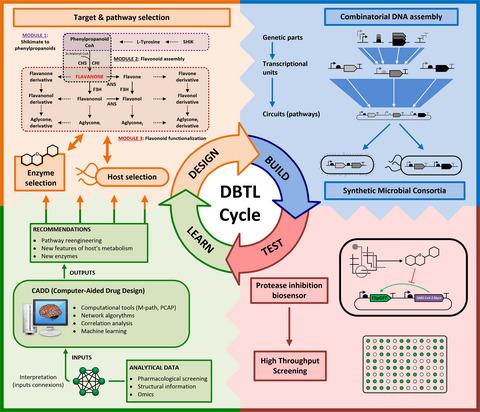当前位置:
X-MOL 学术
›
Microb. Biotechnol.
›
论文详情
Our official English website, www.x-mol.net, welcomes your
feedback! (Note: you will need to create a separate account there.)
Repositioning microbial biotechnology against COVID‐19: the case of microbial production of flavonoids
Microbial Biotechnology ( IF 4.8 ) Pub Date : 2020-10-13 , DOI: 10.1111/1751-7915.13675 Tobias Goris 1 , Álvaro Pérez-Valero 2, 3, 4 , Igor Martínez 5 , Dong Yi 6 , Luis Fernández-Calleja 2, 3, 4 , David San León 5 , Uwe T Bornscheuer 6 , Patricia Magadán-Corpas 2, 3, 4 , Felipe Lombó 2, 3, 4 , Juan Nogales 5, 7
Microbial Biotechnology ( IF 4.8 ) Pub Date : 2020-10-13 , DOI: 10.1111/1751-7915.13675 Tobias Goris 1 , Álvaro Pérez-Valero 2, 3, 4 , Igor Martínez 5 , Dong Yi 6 , Luis Fernández-Calleja 2, 3, 4 , David San León 5 , Uwe T Bornscheuer 6 , Patricia Magadán-Corpas 2, 3, 4 , Felipe Lombó 2, 3, 4 , Juan Nogales 5, 7
Affiliation

|
Coronavirus‐related disease 2019 (COVID‐19) became a pandemic in February 2020, and worldwide researchers try to tackle the disease with approved drugs of all kinds, or to develop novel compounds inhibiting viral spreading. Flavonoids, already investigated as antivirals in general, also might bear activities specific for the viral agent causing COVID‐19, SARS‐CoV‐2. Microbial biotechnology and especially synthetic biology may help to produce flavonoids, which are exclusive plant secondary metabolites, at a larger scale or indeed to find novel pharmaceutically active flavonoids. Here, we review the state of the art in (i) antiviral activity of flavonoids specific for coronaviruses and (ii) results derived from computational studies, mostly docking studies mainly inhibiting specific coronaviral proteins such as the 3CL (main) protease, the spike protein or the RNA‐dependent RNA polymerase. In the end, we strive towards a synthetic biology pipeline making the fast and tailored production of valuable antiviral flavonoids possible by applying the last concepts of division of labour through co‐cultivation/microbial community approaches to the DBTL (Design, Build, Test, Learn) principle.
中文翻译:

重新定位微生物生物技术对抗 COVID-19:微生物生产黄酮类化合物的案例
2019 年冠状病毒相关疾病 (COVID-19) 于 2020 年 2 月成为大流行病,世界各地的研究人员尝试使用各种已批准的药物来应对该疾病,或开发抑制病毒传播的新型化合物。黄酮类化合物已被研究为一般抗病毒药物,也可能具有针对引起 COVID-19、SARS-CoV-2 的病毒因子的特异性活性。微生物生物技术,特别是合成生物学可能有助于大规模生产黄酮类化合物(这是植物特有的次生代谢产物),或者确实有助于发现新的具有药用活性的黄酮类化合物。在这里,我们回顾了以下方面的最新技术:(i) 冠状病毒特异性黄酮类化合物的抗病毒活性,以及 (ii) 来自计算研究的结果,主要是对接研究,主要抑制特定的冠状病毒蛋白,例如 3CL(主要)蛋白酶、刺突蛋白或RNA依赖性RNA聚合酶。最后,我们致力于建立一条合成生物学管道,通过将共培养/微生物群落方法应用到 DBTL(设计、构建、测试、学习)的最新分工概念,从而能够快速、定制地生产有价值的抗病毒黄酮类化合物。 ) 原则。
更新日期:2020-10-13
中文翻译:

重新定位微生物生物技术对抗 COVID-19:微生物生产黄酮类化合物的案例
2019 年冠状病毒相关疾病 (COVID-19) 于 2020 年 2 月成为大流行病,世界各地的研究人员尝试使用各种已批准的药物来应对该疾病,或开发抑制病毒传播的新型化合物。黄酮类化合物已被研究为一般抗病毒药物,也可能具有针对引起 COVID-19、SARS-CoV-2 的病毒因子的特异性活性。微生物生物技术,特别是合成生物学可能有助于大规模生产黄酮类化合物(这是植物特有的次生代谢产物),或者确实有助于发现新的具有药用活性的黄酮类化合物。在这里,我们回顾了以下方面的最新技术:(i) 冠状病毒特异性黄酮类化合物的抗病毒活性,以及 (ii) 来自计算研究的结果,主要是对接研究,主要抑制特定的冠状病毒蛋白,例如 3CL(主要)蛋白酶、刺突蛋白或RNA依赖性RNA聚合酶。最后,我们致力于建立一条合成生物学管道,通过将共培养/微生物群落方法应用到 DBTL(设计、构建、测试、学习)的最新分工概念,从而能够快速、定制地生产有价值的抗病毒黄酮类化合物。 ) 原则。











































 京公网安备 11010802027423号
京公网安备 11010802027423号